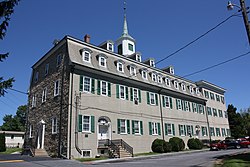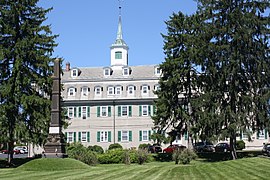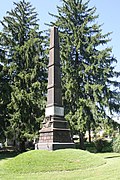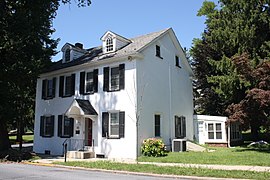
Nazareth is a borough in Northampton County, Pennsylvania, United States. The borough's population was 6,053 at the 2020 census. Nazareth is part of the Lehigh Valley metropolitan area, which had a population of 861,899 and was the 68th-most populous metropolitan area in the U.S. as of 2020.

The Allegheny County Courthouse in downtown Pittsburgh, Pennsylvania, is part of a complex designed by H. H. Richardson. The buildings are considered among the finest examples of the Romanesque Revival style for which Richardson is well known.
Nazareth Hall (1752–1929) was a school in Nazareth, Pennsylvania. It was built, by master mason Melchior Rasp, in 1754 in hopes that Count Nikolaus Ludwig Zinzendorf would return from Europe and settle permanently in the community; he never came back to America. It is located in the Nazareth Hall Tract, listed on the National Register of Historic Places in 1980.

The Moravian Museum of Bethlehem, also known as the 1741 Gemeinhaus and the Lewis David de Schweinitz Residence, is a historic house museum at 66 West Church Street in Bethlehem, Pennsylvania. Built in 1741 to house the early Moravian community as well as the community's place of worship, the Saal, it is the oldest surviving building in Bethlehem, the largest surviving log house in continuous use in the U.S. and also significant for its association with the botanist and mycologist Lewis David de Schweinitz (1780–1834). It was declared a National Historic Landmark in 1975. The building is part of the Historic Moravian Bethlehem District which was designated as a National Historic Landmark District in 2012 and later named to the U.S. Tentative List in 2016 for nomination to the World Heritage List.

The Bethlehem Waterworks, also known as the Old Waterworks or 1762 Waterworks, is believed to be the oldest pump-powered public water supply in what is now the United States. The pumphouse, which includes original and replica equipment, is located in the Colonial Industrial Quarter of downtown Bethlehem, Pennsylvania, between the Monocacy Creek and Main Street. It was declared a National Historic Civil Engineering Landmark in 1971, an American Water Landmark in 1971, and a National Historic Landmark in 1981. The building is a contributing property to the Historic Moravian Bethlehem District which was designated as a National Historic Landmark District in 2012 and later named to the U.S. Tentative List in 2016 for nomination to the World Heritage List.
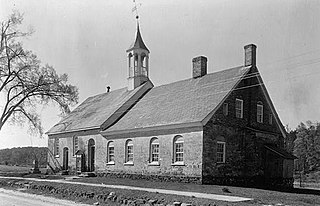
Bethabara Historic District encompasses the surviving buildings and archaeological remains of a small Moravian community, that was first settled in 1753. Located in present-day Forsyth County, North Carolina, it is now a public park of the city of Winston-Salem. It was designated National Historic Landmark in 1999.

The United Methodist Church and Parsonage are a historic United Methodist church and its adjacent historic parsonage located on a 2-acre tract on the corner of East Main Street and Smith Avenue in Mount Kisco, Westchester County, New York. The New Castle Methodist Episcopal Church was designed by J. King in the Carpenter Gothic style of architecture and built in 1868 by Edward Dauchey, while the parsonage, designed in the Victorian style of architecture, was built in 1871. Today the church is known as the United Methodist Church of Mt. Kisco. On November 4, 1982, both the church building and the parsonage were listed on the National Register of Historic Places as a single filing.

Moravian Church is a historic church building located on Swedesboro-Sharptown Road in the Oliphant's Mill section of Woolwich Township, Gloucester County, New Jersey. The church was dedicated in 1789 and documented by the Historic American Buildings Survey (HABS) in 1938. It was added to the National Register of Historic Places on April 3, 1973, for its significance in architecture and religion. The property is currently under the stewardship of the Gloucester County Historical Society.

Parsonage of the Montville Reformed Dutch Church is a historic church parsonage at 107 Changebridge Road in Montville, Morris County, New Jersey, United States.

Zion Lutheran Church, also known as The Lutheran Church of Middle Smithfield, is a historic Lutheran church located in Delaware Water Gap National Recreation Area at Middle Smithfield Township, Monroe County, Pennsylvania. It was built in 1851, and is a one-story, brick building in a modified Greek Revival style. It is built of brick made by members of the congregation and has a slate covered front gable roof.
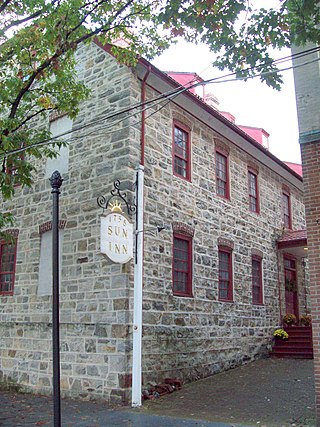
The Moravian Sun Inn was an eighteenth-century inn that was built by the Moravian community in Bethlehem, Pennsylvania to provide accommodations for non-Moravian merchants who had business with the community.

The Tannery is a historic tannery building constructed by the colonial Moravians in Bethlehem, Northampton County, Pennsylvania. It is a limestone building built in 1761, and is part of the Bethlehem Colonial Industrial Quarter.

The Whitefield House and Gray Cottage are two historic homes on the Ephrata Tract in Nazareth, Northampton County, Pennsylvania. Construction on both buildings began in 1740, by Moravian settlers who moved to Nazareth after the failure of their mission to Native Americans and Europeans in the Savannah, Georgia area, 1735–1740. The two structures were added to the National Register of Historic Places on May 1, 1980. The Ephrata Tract and its buildings are owned by the Moravian Historical Society, and act as the Society's headquarters.

The Nazareth Historic District is a national historic district located in the center of the Borough of Nazareth, Northampton County, Pennsylvania, which is located ten miles northeast of Bethlehem and seven miles northwest of Easton.

The Morton Morton House, also known as the Morton Mortonson House and the Morton and Lydia Morton House, is an historic, American home that is located in Norwood, Delaware County, Pennsylvania at the confluence of the Muckinipattis Creek and Darby Creek.

The 1803 House, also known as the Jacob Ehrenhardt Jr. House, is a historic home located in Emmaus, Pennsylvania. It was built in 1803 for Jacob Ehrenhardt Jr., a son of one of the town's founders.

The Historic Moravian Bethlehem Historic District encompasses a complex of the oldest surviving buildings in Bethlehem, Pennsylvania. The National Historic Landmark District is a subset of the larger Central Bethlehem Historic District which is specifically focused on the early buildings constructed by the Moravians who settled the city in the 18th century. The district was designated a National Historic Landmark in 2012 for its unique assemblage of communal religious buildings and history. In 2016 it was named to the U.S. Tentative List for nomination to the World Heritage List.
The Moravian Historical Society in Nazareth, Pennsylvania, was founded in 1857. Its mission is to preserve, interpret, and celebrate the rich culture of the Moravians. It is the third oldest historical society in the Commonwealth of Pennsylvania. The Moravian Historical Society is housed in the 1740-1743 Whitefield House on the Ephrata Tract in downtown Nazareth. The Moravian Historical Society is affiliated with the Moravian Archives in Bethlehem, Pennsylvania, the repository for records of the Moravian Church in North America, Northern Province.

The Asbury Historic District is a 288 acres (117 ha) historic district encompassing the community of Asbury in Franklin Township of Warren County, New Jersey. It is bounded by County Route 632, County Route 643, Maple Avenue, Kitchen Road, and School Street and extends along the Musconetcong River into Bethlehem Township of Hunterdon County. It was listed on the National Register of Historic Places on March 19, 1993 for its significance in architecture, industry, religion, community development, politics/government, and commerce. The district includes 141 contributing buildings, a contributing structure, two contributing sites, and four contributing objects.
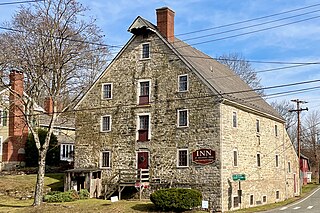
The Hope Historic District is a 40-acre (16 ha) historic district encompassing the Hope section of Hope Township in Warren County, New Jersey, United States. It was added to the National Register of Historic Places on July 20, 1973, for its significance in architecture, community development, commerce, engineering, exploration/settlement, industry, and religion. The district includes 17 contributing buildings, 1 contributing site, and 1 contributing structure. St. Luke's Episcopal Church was later listed individually on the NRHP.
